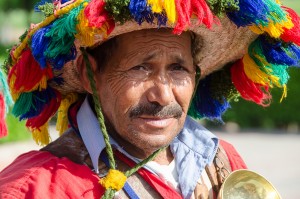It wasn’t that long ago that many travel photos were taken, developed and then dumped into boxes, rarely to be seen again. These days, things aren’t so different except that now the photos get dumped onto external hard drives.
In most collections of vacation and travel photos, a precious few of the very best shots are often spared this fate – those photos that are somehow more enduring or more interesting, or that best capture the spirit and sensation of the trip. What is it that keeps these photos from the dustbin of our traveling history? Often they are simply better photographs. That is, the “keeper” photo isn’t of a favorite person, place or activity – it is better composed, better lit and thus simply more visually interesting than the run-of-the-mill vacation snapshot.
Following is a collection of low- and no-tech tips to help you improve your photography skills for your next trip.
Think “people, places, things.” 
This old definition of the use of a noun is a handy guide to a great vacation photo: the best travel photos will often be about all three of these. To illustrate, let’s say you want to take a photo of the Tower of London on a rainy day. If you pull up your photo and snap the Tower in the gray light, you could get a decent photo. But if you put your friends in the photo with the Tower glimpsed over their shoulders (the place of interest), visible just under the rim of an umbrella (a very specific thing that evokes the conditions), you have a great shot.
Get closer. 
As Robert Capa famously said, “If your pictures aren’t good enough, you’re not close enough.” Taken literally, the closer you get to your subject, the more detail and interest you can capture.
There are a couple of ways to do this, both equally valid and effective. One is to use the telephoto features found on most cameras to zoom in on your subject. Before anyone cries cop-out, this can be a very effective photographic technique, and has resulted in countless compelling images in this age of big lenses.
The other is simply to walk closer to your subject. Not everyone is comfortable doing this, but the person viewing the photo will appreciate it; despite how close a zoom lens makes things appear, when viewing a photo the human eye can still sense the distance, and appreciates when an image has truly been taken up close.
Be in the thick of it.
A less literal read of Capa’s statement, and probably the one closer to his intent, suggests that Capa likes photos in which the photographer him- or herself seems to be part of what is going on, and not standing apart from the action. Capa’s solution to get more intimate, engaged photos is simply to be more intimately involved in the photo yourself.
 Know where the sun is.
Know where the sun is.
The easiest way to flatter your subject is to put it in the best light. If you want your subjects’ faces to shine, turn them so the sun is shining on their faces. If you want your photo of your cruise ship to look like the brochures, take the photo on the sunny side of the ship. Alternately, if you want to catch the glistening of light on the ocean, take the photo when the sun is low enough to bounce off the waves.
Consider the time of day.
This is a fairly simple story – there’s no time like sunrise or sunset to take compelling, interesting and even stunning travel photos. Sunrise in particular can produce very striking images, in part because most people are not awake at the crack of dawn, and so can still be surprised by a sunrise photo.
Turn the camera on its side.
In some situations, turning the camera on its side to take a vertical shot is just not good composition, it is almost essential. But taking vertical shots also has an added benefit: it will enhance the interest of your overall photo collection considerably, adding geometrical variety as folks flip through your vacation slideshow.
 Fill the frame.
Fill the frame.
The interesting parts of the scene should start at the left edge of the viewfinder and end at the right edge. That is, the subject should absolutely fill the frame such that the edges of the photo will include as little superfluous imagery and information as possible.
I find this tactic offers a couple of distinct advantages. First, the intended subject of your photo is absolutely clear to anyone who sees the photo. And second, the photo becomes a thing apart from how we usually see the world, which is more or less in 180-degree panorama thanks to our peripheral vision. A photograph can isolate and amplify our experience, which turns out to be one of the attractions of travel itself, as well.
 Divide the scene into threes.
Divide the scene into threes.
If you put something right in the middle of the frame, the photo is about that thing. Another great tactic for creating visual interest in a somewhat routine shot is to frame the shot such that your subject is not in the dead middle of the photo, but is placed off-center in the frame. An easy way to think about this is mentally to divide the frame into three sections (left, center and right), and put the main subject of the photo either entirely within the left or right section, or perhaps right on the line dividing two sections.
How to choose on which side to put the subject? This is easy – put it on the side that has the least background interest in the overall frame. This way, the viewer can be tricked into thinking you took a photo of both the subject and the background activities, with equal emphasis on both.
You can also divide the photo vertically into threes as well so that you have a grid of nine squares total to work with.
When taking photos of traveling companions, it is easy to prop them up in front of something interesting and then take the picture. If you go to some effort to get the attraction behind them, but cut off the top of someone’s head, or include a sloppy untucked shirt, or cut the photo off at someone’s socks, you have a good photo of the sight and a terrible photo of your friends. In this case, frame them first and then worry about the background.
Move.
I find that very often a decent photo could have been a great photo if I had just moved a little bit, whether to reframe the photo slightly, or to put something interesting into the background. This can involve moving a few steps forward or back, shifting to one side or the other, or crouching down. As a photographer, you have much more control over what you are doing and where you are standing than you do over the subject matter; if you just stand lead-footed in one spot, your photos will reflect this.
Zoom in and out until you like what you see.
If your camera has a zoom feature, and most do these days, you can help yourself to “move” by zooming in and out on your subject. I find that when you do this, at the point the scene becomes most interesting, your eye will notice it – that is, you’ll just like it more intuitively. That’s when you take the shot.
 Pay the most attention to the edges and corners.
Pay the most attention to the edges and corners.
A great photo is as often defined by what is left in as by what is left out. You have considerable control here, and while it is normal human behavior to look directly and in a concentrated way at the things that interest us most, the camera behaves otherwise.
Very often you can take a photo that seems like it might turn out extremely well, but when you see the print of a photo, your friend is a speck in the middle of a nondescript background. Take all that stuff out, and you have a great photo.
In the same way, if you zoom in very closely on someone’s face, and cut out the monkey standing on her head, you missed the shot.
 At familiar sites, emphasize something other than the subject.
At familiar sites, emphasize something other than the subject.
If you are photographing the Eiffel Tower, Big Ben, Mount Rushmore or any other frequently photographed site, you would often do better to buy a nice calendar than take yet another point-and-shoot photo that will just take up space on your hard drive until it crashes.
But if you make it a photo about something else – your companion’s goofy hat with the Eiffel Tower in the background, or a bobby in front of the Houses of Parliament, or a motorcycle gang parked in front of Mount Rushmore – then you have a great photo.
Look, then think, before you shoot.
Before taking a photo, if you just take a quick look at your surroundings, and give yourself a second to think about anything interesting that might be happening, you will get a much higher percentage of interesting photos than if you simply pull your camera to your eye and snap without planning what you want to capture.
 Try to take photos where you didn’t “have to be there.”
Try to take photos where you didn’t “have to be there.”
If you want to take a great photo and not merely a snapshot of your traveling companions in a certain location, think about how a complete stranger would react to seeing your picture. Photos that are thereby intrinsically interesting will enhance and retain their interest to you as well.
Use your sense of humor.
Do not underestimate the value of capturing or expressing a little humor when taking travel photos. Travel is usually as much about how we felt and thought while traveling, not just where we went, and photos that capture some humor often bring back the strongest memories and sensations as time goes by.
Edited from article in Independent Traveler












